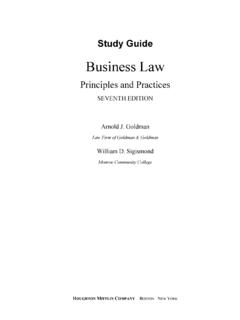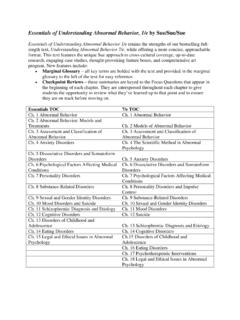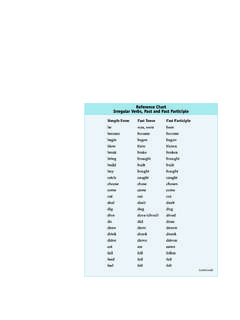Transcription of C 1 APPENDIX C Sample Marketing Plan - Cengage
1 APPENDIX CSample Marketing PlanC 1 Copyright Houghton Mifflin Company. All rights 1 Copyright Houghton Mifflin Company. All rights Marketing PlanThis Sample Marketing plan for a hypothetical companyillustrates how the marketingplanning process described inChapter 2 might be implement-ed. If you are asked to create amarketing plan , this model maybe a helpful guide, along withthe concepts in Chapter Environmental Analysis presents informationregarding the organization s cur-rent situation with respect to themarketing environment, the cur-rent target market(s), and thefirm s current Marketing objec-tives and section of the environ-mental analysis considersrelevant external environmentalforces such as competitive, eco-nomic, political, legal and regula-tory, technological, and sociocul-tural Executive Summary, one of the most frequentlyread components of a marketingplan, is a synopsis of the market-ing plan .
2 Although it does notprovide detailed information, itdoes present an overview of theplan so readers can identify keyissues pertaining to their roles inthe planning and implementa-tion processes. Although this isthe first section in a marketingplan, it is usually written last. 123 Star Software, PlanI. EXECUTIVE SUMMARYStar Software, Inc., is a small, family-owned corporation in the first year of a transi-tion from first-generation to second-generation leadership. Star Software sells custom-made calendar programs and related items to about 400 businesses, whichuse the software mainly for promotion.
3 Star s 18 employees face scheduling chal-lenges, as Star s business is highly seasonal, with its greatest demand duringOctober, November, and December. In other months, the equipment and staff aresometimes idle. A major challenge facing Star Software is how to increase profitsand make better use of its resources during the evaluation of the company s internal strengths and weaknesses and externalopportunities and threats served as the foundation for this strategic analysis andmarketing plan . The plan focuses on the company s growth strategy, suggestingways in which it can build on existing customer relationships, and on the develop-ment of new products and/or services targeted to specific customer niches.
4 SinceStar Software markets a product used primarily as a promotional tool by its clients,it currently is considered a business-to-business ENVIRONMENTAL ANALYSISF ounded as a commercial printing company, Star Software, Inc., has evolved into amarketer of high-quality, custom-made calendar software and related business-to-business specialty items. In the mid-1960s, Bob McLemore purchased the companyand, through his full-time commitment, turned it into a very successful family-runoperation. In the near future, McLemore s 37-year-old son, Jonathan, will take overas Star Software s president and allow the elder McLemore to scale back The Marketing competition in the specialty advertising industry is verystrong on a local and regional basis but somewhat weak nationally.
5 Sales fig-ures for the industry as a whole are difficult to obtain since very little businessis conducted on a national competition within the calendar industry is strong in the paper seg-ment and weak in the software-based segment. Currently paper calendars hold adominant market share of approximately 90 percent; however, the software-123C-1 Copyright Houghton Mifflin Company. All rights segment is growing rapidly. The 10 percent market share held by software-based calendars is divided among many different firms. Star Software,which holds 30 percent of the software-based calendar market, is the only com-pany that markets a software-based calendar on a national basis.
6 As software-based calendars become more popular, additional competition is expected toenter the , many companies have reduced their overall pro-motion budgets as they face the need to cut expenses. However, most of thesereductions have occurred in the budgets for mass media advertising (television,magazines, newspapers). While overall promotion budgets are shrinking, manycompanies are diverting a larger percentage of their budgets to sales promotionand specialty advertising. This trend is expected to continue as a weak, slow-growth economy forces most companies to focus more on the value theyreceive from their promotion dollar.
7 Specialty advertising, such as can be donewith a software-based calendar, provides this are no expected political influences or events that couldaffect the operations of Star and regulatory recent years, more attention has been paid to junk mail. A large percentage of specialty advertising products are distributedby mail, and some of these products are considered junk. Although this labelis attached to the type of products Star Software makes, the problem of junkmail falls on the clients of Star Software and not on the company itself. Whilelegislation may be introduced to curb the tide of advertising delivered throughthe mail, the fact that more companies are diverting their promotion dollars tospecialty advertising indicates that most companies do not fear the potential forincreased major emerging technological trend involves personalinformation managers (PIMs), or personal digital assistants (PDAs).
8 A PDA is ahandheld device, similar in size to a large calculator, that can store a wide vari-ety of information, including personal notes, addresses, and a calendar. SomePDAs even have the ability to fax letters via microwave communication. As thistrend continues, current software-based calendar products may have to beadapted to match the new today s society, consumers have less time for work orleisure. The hallmarks of today s successful products are convenience and easeof use. In short, if the product does not save time and is not easy to use, con-sumers will simply ignore it.
9 Software-based calendars fit this consumer needquite well. A software-based calendar also fits in with other societal trends: amove to a paperless society, the need to automate repetitive tasks, and the grow-ing dependence on computers, for CSample Marketing PlanC 3 Copyright Houghton Mifflin Company. All rights Target Market(s)By focusing on commitment to service and quality, Star Software has effectivelyimplemented a niche differentiation strategy in a somewhat diverse marketplace. Itsability to differentiate its product has contributed to superior annual returns.
10 Its tar-get market consists of manufacturers or manufacturing divisions of large corpora-tions that move their products through dealers, distributors, or brokers. Its mostprofitable product is a software program for a PC-based calendar, which can be tai-lored to meet client needs by means of artwork, logos, and text. Clients use this cal-endar software as a promotional tool, providing a disk to their customers as anadvertising premium. The calendar software is not produced for calendar software began as an ancillary product to Star s commercialprinting business. However, due to the proliferation of PCs and the growth in tech-nology, the computer calendar soon became more profitable for Star than its walland desktop paper calendars.


















